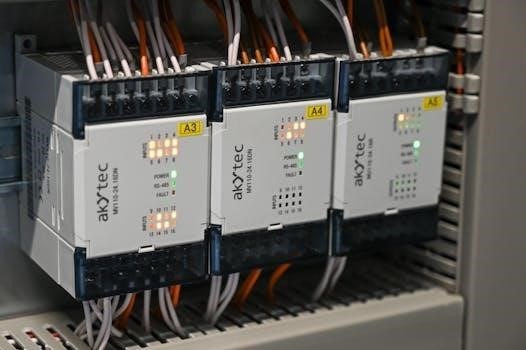
adblue system fault see owners manual mercedes
AdBlue System Fault⁚ Mercedes-Benz Owner’s Manual
Consult your Mercedes-Benz owner’s manual for detailed information regarding your vehicle’s AdBlue system․ The manual provides crucial guidance on identifying potential faults, understanding warning messages, and recommended actions․ It includes troubleshooting tips and specific instructions for your model․
Understanding the AdBlue System in Mercedes-Benz Vehicles
Mercedes-Benz vehicles utilize the AdBlue system to reduce harmful nitrogen oxide (NOx) emissions, complying with stringent environmental regulations․ This system injects AdBlue, a urea-based fluid, into the exhaust stream․ This process occurs before the selective catalytic reduction (SCR) catalyst․ The SCR catalyst converts NOx into harmless nitrogen and water․ A properly functioning AdBlue system is crucial for optimal engine performance and environmental responsibility․
The AdBlue system consists of several components, including a reservoir, pump, injector, and control unit․ The control unit monitors NOx levels and regulates AdBlue injection accordingly․ Fault codes, such as P13E400, indicate potential issues with the system․ These issues may relate to fluid levels, sensor malfunctions, or component failures․ Regular maintenance and prompt attention to warning messages are vital․ This ensures the continued effectiveness of the AdBlue system and avoids potential limitations on driving distance․
Common AdBlue System Fault Codes
Several fault codes can indicate problems within the Mercedes-Benz AdBlue system․ One prevalent code is P13E400, often signaling a limited remaining driving distance due to an AdBlue issue․ This code might arise from low fluid levels, a malfunctioning sensor, or a problem with the AdBlue injector․ Other common codes may point to issues with the AdBlue pump, heater, or the overall SCR system efficiency․ These codes are essential for diagnosing the root cause of the malfunction․
Diagnostic scans are crucial for identifying these fault codes․ These scans assist in pinpointing the specific component or area requiring attention․ Ignoring these codes can lead to reduced engine performance, increased emissions, and potential limitations on vehicle operation․ Early detection and resolution of these issues are vital for maintaining optimal vehicle performance and adhering to environmental standards․ Refer to your Mercedes-Benz owner’s manual or consult a qualified technician for accurate diagnosis and repair․

Troubleshooting AdBlue Faults⁚ Initial Steps
Begin troubleshooting AdBlue faults by checking the fluid level; Then perform a diagnostic scan to identify any stored trouble codes․ These initial steps will provide valuable information about the system’s condition and potential problems․
Checking the AdBlue Fluid Level
The first step in troubleshooting AdBlue system faults is to verify the AdBlue fluid level․ A low fluid level is a common cause of warning messages and can prevent the system from functioning correctly․ Consult your Mercedes-Benz owner’s manual to locate the AdBlue reservoir․
The reservoir is often located in the trunk or engine compartment, depending on the model․ Open the reservoir cap and visually inspect the fluid level․ If the level is below the minimum mark, refill the tank with the correct type of AdBlue fluid, as specified in your owner’s manual․
Ensure you use the correct fluid to avoid damaging the system․ After refilling, the warning message may not disappear immediately․ You might need to drive for a short period or perform a system reset, as described in your owner’s manual, or using diagnostic tools for resetting․
Ignoring low AdBlue levels can lead to performance limitations and potential engine damage․ Therefore, regular monitoring and timely refilling are crucial for maintaining optimal vehicle performance and avoiding costly repairs․
Performing a Diagnostic Scan
After checking the AdBlue fluid level, performing a diagnostic scan is the next crucial step․ This scan helps identify specific fault codes related to the AdBlue system, providing valuable insights into the nature of the problem․ Use an OBD-II scanner compatible with Mercedes-Benz vehicles․
Connect the scanner to the diagnostic port, typically located under the dashboard․ Turn on the ignition and follow the scanner’s instructions to initiate a scan․ Record any fault codes that appear, as these codes will be essential for further troubleshooting․ Common codes may relate to sensor malfunctions, pump failures, or issues with the SCR system․
Once you have the fault codes, consult your Mercedes-Benz owner’s manual or a reliable online resource to understand their meaning․ Some codes may indicate simple issues that you can resolve yourself, while others may require professional attention․
Clearing the codes after addressing the underlying problem is also essential, but be aware that some codes might reappear if the issue persists․ Regularly scanning for faults can help prevent major damage․

AdBlue System Reset Procedures
Resetting the AdBlue system might be necessary after refilling the fluid or addressing a fault․ Consult your owner’s manual for specific reset procedures, as methods vary between Mercedes-Benz models and may require diagnostic tools․
Resetting After Refilling AdBlue
After refilling your Mercedes-Benz AdBlue tank, a system reset might be necessary to clear warning messages․ The procedure varies depending on the vehicle model, so consulting your owner’s manual is crucial․ Some models automatically reset after driving a short distance․ Others may require a manual reset through the vehicle’s onboard computer or infotainment system․
Refer to your Mercedes-Benz owner’s manual for step-by-step instructions specific to your vehicle․ It typically involves navigating the menu system to the AdBlue or emissions section and selecting the “Reset” or “Clear Fault” option․ Always ensure the AdBlue tank is adequately filled before attempting a reset․ Incorrect procedures could lead to further complications or error codes․
If the warning message persists despite refilling and attempting a reset, a deeper diagnostic scan might be needed to identify any underlying issues within the AdBlue system․ Consider seeking professional assistance for complex problems․
Using Diagnostic Tools for Reset
Diagnostic tools offer a more advanced method for resetting the AdBlue system in Mercedes-Benz vehicles, particularly when a simple reset after refilling proves ineffective․ These tools, often used by mechanics, can communicate directly with the vehicle’s computer to clear fault codes and recalibrate the system․ They provide a deeper level of access and control compared to the standard onboard reset procedures․
Using a diagnostic tool typically involves connecting it to the vehicle’s OBD-II port and following the tool’s on-screen instructions․ The tool will scan for any stored fault codes related to the AdBlue system and allow you to clear them․ In some cases, it may also be necessary to perform a system adaptation or calibration to ensure proper functioning․
It’s crucial to use a diagnostic tool that is compatible with your Mercedes-Benz model․ Refer to the tool’s documentation or consult with a professional to ensure proper usage and avoid causing unintended damage to the vehicle’s system․ Incorrectly using a diagnostic tool can potentially lead to further complications․

Advanced Troubleshooting and Solutions
When initial troubleshooting steps fail, advanced solutions may be necessary․ This includes addressing persistent trouble codes, such as P13E400, and exploring options like AdBlue system deletion or calibration by professionals familiar with Mercedes-Benz vehicles․
Addressing Persistent Trouble Codes (e․g․, P13E400)

Persistent trouble codes, like the often-cited P13E400, indicate a more complex issue within the AdBlue system requiring detailed attention․ This specific code often relates to limitations in the remaining driving distance due to AdBlue system malfunctions․ A full diagnostic scan is crucial to confirm the code and identify any related issues․
Attempting to reset the system without addressing the underlying problem will likely result in the code reappearing․ Check for common culprits such as faulty sensors, a malfunctioning AdBlue pump, or blocked injectors․
Consulting a qualified Mercedes-Benz technician is highly recommended for accurate diagnosis and repair; They can perform specialized tests, analyze system data, and implement appropriate solutions, potentially involving component replacement or software recalibration․ Ignoring persistent codes can lead to further damage and restricted vehicle operation․ Remember to always prioritize professional assistance when dealing with complex AdBlue system faults․
Considering AdBlue System Deletion (Calibration)
AdBlue system deletion, also known as calibration or removal, involves modifying the vehicle’s software to bypass the AdBlue system entirely․ This is often considered as a last resort when facing recurring and costly AdBlue system failures․ Calibration essentially disables the AdBlue injection process․
While it eliminates the need for AdBlue refills and repairs, it is crucial to understand the implications․ Removing the AdBlue system typically renders the vehicle non-compliant with emissions regulations, potentially leading to legal issues during inspections or resale․
Furthermore, it may affect the vehicle’s warranty and potentially impact engine performance․ If considering this option, thoroughly research the legal and technical aspects, and consult with reputable tuning specialists experienced in AdBlue system deletion․ Be aware of the potential environmental consequences and ensure compliance with local laws․ This decision should not be taken lightly;